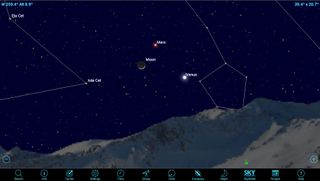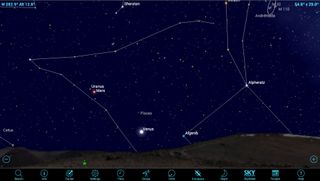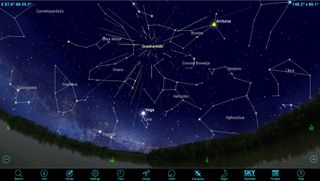Previewing 2017's Biggest Skywatching Events Using Mobile Astronomy Apps — Part 1

The big astronomy story for 2017 will be the Great American Total Solar Eclipse of August 21. But there are plenty of other must-see events that you should add to your calendar for the coming year. Mobile astronomy apps can tell you more about them and help you plan to see them for yourself.
In this edition of Mobile Astronomy, we'll tell you how you can use Mars to see nearly all the planets through your binoculars or backyard telescope, including tough-to-find Uranus and Neptune. We'll also highlight the best meteor showers of 2017 and the best times to see Venus' phases and its brightest appearance.
Don't worry — part two will cover the eclipse, as well as opportunities to see Mercury shine, Jupiter's moons cross the planet and our own moon cover a star. The fun begins in the wee hours of Jan. 1, so let's get started! [The 100 Best Space Photos of 2016]
Mars closely passes the other planets
In our solar system, all the planets' orbits are slightly tilted with respect to one another. The ecliptic is the great arc across the sky that represents the Earth's orbit around the sun — and since the Earth's orbital inclination isn't too extreme, it's also roughly the plane of the solar system. So we always observe the planets within a broad strip of sky on either side of the ecliptic, and the faster-moving planets often pass near to the more distant, slower-moving ones.
As viewed from Earth, Mars can veer more than 6 degrees from the ecliptic (about a palm's width held at arm's length), but during 2017, it will stay within about 1 degree (a finger's width) of it. That positioning will set up a series of telescopic treats; Mars passes so close to most of the classical planets that we'll be able to see each pairing together in a backyard telescope's field of view. Everyone will get to see the pairings, regardless of the observer's location on Earth, but the moment of closest separation with each planet happens on a specific date and time. Your astronomy app can give you a preview of each event, tell you whether the planets will be above the horizon for you at that time and whether the sky will be dark enough for you to see them.
Strong binoculars will be powerful enough to see most of these planet pairings, but a small telescope will be even better. You just need to know where to look. Be aware that your telescope may invert and/or flip the view left to right, which might require you to swing your scope in different directions than expected to spot your target. The planets will still be relatively close to one another on the evenings before and after the close pass, so you may wish to practice finding them ahead of time.
To preview an event with your app, just set it to the date mentioned, then search for and center Mars in the app's view. Run time forward and backward to see the planets approach and move apart. You'll want to zoom in to see the symbols for the distant, dimmer planets. If they are below the horizon, or if the sun is up, you won't be able to see them where you are — but you can use the app to see the closest times when they will be visible for you. Let's run down the list of events. [Hubble Telescope Captures Incredible Up-Close View of Mars]
Get the Space.com Newsletter
Breaking space news, the latest updates on rocket launches, skywatching events and more!
Mars and Neptune: Our first pairing occurs just as we are ringing in 2017. Over the past several weeks, Mars has been traveling straight toward the tiny blue planet Neptune, which is sitting about midway between the stars Lambda and Sigma in the constellation Aquarius the Water-Bearer (use your app to see Neptune's location with respect to these stars). About 2 a.m. EDT (0700 GMT) on Sunday, Jan. 1, Mars will pass within only 1 arc-minute of Neptune (1/30th of the moon's diameter), and they'll both easily fit into the view of your telescope's eyepiece — a study in blue and red! Even a small telescope will be sufficient for you to see the two planets at the same time, and they're so close that a stronger-magnification eyepiece can also be used.

Observers on the West Coast and the Pacific Ocean will be able to see Mars and Neptune at closest approach. Unfortunately, for eastern North America, the two planets will set at about 9:45 p.m. EDT (0245 GMT Jan. 2), while Mars is still 8 arc-minutes below Neptune. But that's still a very tight telescopic grouping. If it's cloudy Saturday, have a look early on Sunday evening, when Mars will still be only 0.5 degrees (the moon's diameter) away from Neptune, to its upper left.
Mars and Uranus: Just after 7 p.m. EDT on the evening of Sunday, Feb. 26 (0000 GMT Feb. 27), Mars will pass within 34 arc-minutes (almost the moon's diameter) to the upper right of blue-green Uranus. The pair of planets will be in the lower third of the western sky, situated between the strings of stars that define the two fishes of Pisces. The two planets should fit together in the field of view of a low-power eyepiece, regardless of telescope. For a reference to help find them, Venus will be shining brightly, about 11 degrees to the lower right.

Mars and Mercury: On the morning of Saturday, Sept. 16, Mars will pass very close to Mercury, within only about 3 arc-minutes. For observers in the eastern U.S. and Canada, closest approach happens in broad daylight about 2:30 p.m. EDT (1830 GMT), so they will have to settle for seeing the two planets about 18 arc-minutes apart before dawn, between the time when Mars rises (about 5:30 a.m. EDT, or 0930 GMT) and 6:30 a.m. EDT (1030 GMT). Look for them low in the eastern sky. In your telescope, the two planets will appear together when you use a low-power eyepiece. Mercury, sitting above the red planet, will be much brighter than Mars, and its disk will be only 64 percent full. The following morning, Mercury will be below Mars. Observers in other parts of the world can check their astronomy app to see how far apart the two planets will be where they are. (Note: For morning planet pairings, be sure that the sun is completely below the horizon whenever you are using a telescope that is aimed near the horizon.) [How to Spot Mercury and the Solar System's 'Racetrack' Using Mobile Apps]
Mars and Venus: On Oct. 5, Mars will pass within 12 arc-minutes of Venus for a few hours that will be centered on noon EDT. Once again, the best views will occur in the eastern morning sky between 5:30 a.m. local time and sunrise, when the two planets will be separated by only 17 arc-minutes — with much brighter Venus situated to the upper left of fainter, reddish Mars. Observers on the West Coast will see the two planets rise in the closer configuration.
Leaving Mars for the moment, Venus will pass very close to the left of Jupiter on the morning of Nov. 13, when the two brightest planets will shine through the morning twilight low on the eastern horizon, separated by only 16 arc-minutes (about half the moon's diameter). The two will easily fit into the field of view of a low-power eyepiece. Venus will be brighter than Jupiter, and on the left. Look for Jupiter's four Galilean satellites, which will appear in an upright line around the planet. You might also be able to tell that Venus' disk is only 97 percent full.

To use your app to look for more matchups between the planets, the moon and bright stars, pick a convenient time of evening, select a planet and center it. Then advance the date and watch for other objects to appear nearby. Don't zoom in too closely, or you'll miss some of them. In SkySafari 5, you can use the Display settings menu to enable a field-of-view circle for your binoculars or telescope. If the planet sets, or the summer sky doesn't get dark enough, just choose another time and keep going. It's fun!
2017's best meteor showers
Meteor showers are a terrific excuse to get out under the stars and take in the splendor of the sky as you wait for the shooting stars. The showers are produced when the Earth travels through debris fields that are left behind by repeated passages of periodic comets. The debris particles burn up in our atmosphere, creating streaks of light, or "shooting stars." Showers can last for several days, or many weeks, depending on how spread-out the region of debris is. The number of meteors per hour climbs to a peak value, known as the zenith hourly rate, or ZHR, as we approach the densest portion of the debris field, and then tapers off. Meteor showers repeat on the same dates every year, when the Earth returns to the same place in its orbit. [How Meteor Showers Work (Infographic)]
During the shower period, you can look for meteors anywhere in the night sky, but they will be traveling away from a particular location in the sky that corresponds to the Earth's direction of travel (just as bugs splatter on a car's front windshield). This radiant point is usually near a particular star or constellation, and it gives the shower its name. The best time to look is when your sky overhead is plowing straight into the cloud of debris that generates the shower, usually after midnight. More meteors are visible if the sky is dark, so the moon plays a major role in determining how good a shower will be each year. Astronomy apps like SkySafari 5 Plus for iOS and Android have information about all of the major showers. You can also download the free Meteor Shower Calendar app for Android and iOS, or the American Meteor Society Meteors app for Android and iOS. The calendar app issues notifications of upcoming showers and includes weather forecasts, moon phases and historical data.
As 2017 kicks off, watch for a good shower known as the Quadrantid meteor shower. The annual event runs from Dec. 30 to Jan. 12, and peaks before dawn on Wednesday, Jan. 4. The source material for these meteors is an asteroid that's designated as 2003 EH. The average hourly rate is about 25, but during the short, intense peak period, you might see more than 100 per hour! The Quadrantid meteor shower is named for a former constellation called the Mural Quadrant, which was located between Hercules and the tip of the Big Dipper, so Quadrantid meteors will appear to be traveling away from a location in the northeastern sky below the Big Dipper. This year, the moon will be a waxing crescent on the peak dates and will not be in the sky before dawn, giving us a darker sky and a better show. [See Amazing Photos from Past Quadrantid Meteor Showers]

On the peak night of Aug. 11 to 12, the sky for the popular and prolific summertime Perseid meteor shower will be washed out by a waning gibbous moon, spoiling the fun. But 2017 will end in good form with the Geminid meteor shower, which runs from Dec. 4 to 16 and peaks overnight on Dec. 13 to 14, when we can expect to catch as many as 100 meteors per hour. On the peak date of one of the best showers of the year, the moon will be a waning crescent that rises just before dawn, leaving us with nice dark skies for seeing the show. The Geminids are often bright and intensely colored, and slower-moving than average. Unlike most meteor showers, the source material is thought to be an asteroid (called 3200 Phaethon) and not a comet. This means that the debris is likely larger and more solid — giving us more spectacular meteors! The radiant is located near the star Castor in Gemini, sitting in the southwestern sky after midnight.
Venus' best events
Venus has been gracing the western evening sky for months, but early 2017 brings us the best viewing events for our sister planet. On the evening of Thursday, Jan. 12, Venus will reach its widest angle east of the sun. On that evening, it will reach its highest point in the sky, allowing us to view it with the least amount of distortion from turbulence in the Earth's atmosphere. It will also be setting well after the sun, shining like a beacon in a dark sky. As a bonus, on that evening only, Venus will be located less than 23 arc-minutes to the upper right of Neptune. Both planets should fit nicely into the field of view of a low-power eyepiece in a small telescope.
When Venus swings wide of the sun, we see it illuminated only on the sunward side. On the evening of Saturday, Jan. 14, Venus will exhibit an exactly half-illuminated phase, similar in shape to a first-quarter moon. Strong binoculars might hint at the asymmetry in the planet's illumination, but a small telescope will definitely show it. Around the time of greatest eastern elongation, Venus is heading straight toward the Earth, so it will be growing in disk diameter and brightening as we close the distance between us. In the subsequent weeks, it will swing west and sunward as it prepares to move into inferior conjunction with the sun on March 25. While this happens, its phase will continue to wane toward a thin crescent. The combination of distance and phase will cause Venus to reach a peak brightness of visual magnitude -4.85 on Sunday, Feb. 19. This will be brighter than every night sky object except the moon.

Going beyond
For purely visual treats, here are a few more must-sees to put on your calendar. Many of these will make terrific binocular views or nice photo ops when you use a tripod-mounted camera or your mobile device. Wide-field astroimages look nicer when they're framed by interesting trees or landscapes. To compose your photo, use your astronomy app to preview where in the sky they'll be.
In the western sky in early evening on Monday, Jan. 2, look for a beautiful alignment of Venus, the crescent moon and Mars — all separated by only 11 degrees (about an outstretched fist's diameter). On Jan. 31, the moon will return, and the three objects will form a tight triangle. In the southern pre-dawn sky of Feb. 15 and 16, the waning gibbous moon will be grouped with Jupiter and the bright star Spica in Virgo, and they'll gather again on March 15 and April 10.
In the next edition of Mobile Astronomy, we'll preview more 2017 highlights, including the total eclipse and opportunities to see Mercury, the dance of Jupiter's moons and Earth's moon hide a star. Until then, keep looking up!
Editor's note: Chris Vaughan is an astronomy public outreach and education specialist, and operator of the historic 1.88-meter David Dunlap Observatory telescope. You can reach him via email, and follow him on Twitter as @astrogeoguy, as well as on Facebook and Tumblr.
This article was provided by Simulation Curriculum, the leader in space science curriculum solutions and the makers of the SkySafari app for Android and iOS. Follow SkySafari on Twitter @SkySafariAstro. Follow us @Spacedotcom, Facebook and Google+. Original article on Space.com.
Join our Space Forums to keep talking space on the latest missions, night sky and more! And if you have a news tip, correction or comment, let us know at: community@space.com.
Chris Vaughan, aka @astrogeoguy, is an award-winning astronomer and Earth scientist with Astrogeo.ca, based near Toronto, Canada. He is a member of the Royal Astronomical Society of Canada and hosts their Insider's Guide to the Galaxy webcasts on YouTube. An avid visual astronomer, Chris operates the historic 74˝ telescope at the David Dunlap Observatory. He frequently organizes local star parties and solar astronomy sessions, and regularly delivers presentations about astronomy and Earth and planetary science, to students and the public in his Digital Starlab portable planetarium. His weekly Astronomy Skylights blog at www.AstroGeo.ca is enjoyed by readers worldwide. He is a regular contributor to SkyNews magazine, writes the monthly Night Sky Calendar for Space.com in cooperation with Simulation Curriculum, the creators of Starry Night and SkySafari, and content for several popular astronomy apps. His book "110 Things to See with a Telescope", was released in 2021.


